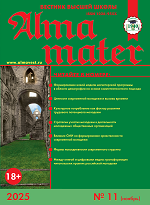UDC 069+304
Larisa S. Perevozchikova, Dr. Sci. (Philosophy), Docent, Head of Department, Voronezh State Technical University, e-mail: pls@cchgeu.ru
Rimma V. Dorokhina*, Cand. Sci. (Philosophy), Associate professor, Voronezh State Technical University, e-mail: dor-rimma@yandex.ru
Maria V. Marina, Director of the Museum of Engineering, Voronezh State Technical University, e-mail: mary.medvedeva84@yandex.ru
The Rumyantsev Museum is called the treasure of the two capitals, but with the same reason it can be considered the treasure of the country. And although the museum itself and its unified collection ceased to exist (the collection has disintegrated and is now part of the collection of the Russian Museum, the Hermitage, etc.), with its complex almost century-old existence, it contributed to the formation of the museum as a social institution. The Rumyantsev Museum was formed with the participation of the public, united around Nikolai Petrovich Rumyantsev — the Rumyantsev Circle.
In the literature, the term ‘Rumyantsev Circle’ is usually understood as an informal association of scientists, historians, librarians, journalists, archaeologists and collectors. The leader and founder of the circle was Nikolai Petrovich Rumyantsev. The very concept of ‘Rumyantsev circle’ appeared in historiography in the second half of the XIX century. The period of existence of the circle is approximately from 1813 to 1826 (before the death of N. Rumyantsev). According to different data the number of the circle — more than 200 people, about 55 made its core. The approximate composition is known: 26 people were employees, 7 — professors and teachers of various educational institutions, 4 — academicians and 12 — people who were in the service of Rumyantsev.
The activities of the Rumyantsev circle had not only scientific, but also social significance. Historical works and ancient sources positively influenced the self-consciousness of the progressive Russian public, including such names as A. Pushkin, D. Venevitinov, V. Odoevsky, Decembrists, etc. In particular, the work of the members of the circle was aimed at participating in various ethnographic and geographical expeditions, as well as archaeological excavations.
Keywords: museum, enlightenment, social institute, social associations, academic activity, Rumyantsev, Rumyantsev circle.
References
1. Vaskin, A.A. Discovering Moscow: walks on the most beautiful. Moscow buildings. Moscow: Eterna. 2016. 295 p.
2. Vishnevskaya. E.E. V.F. Odoevsky and the rescue of the Rumyantsev Museum (to the question of the role of legal documents in preserving the cultural heritage of Russia). International Legal Courier. 2014. No. 4. P. 16–20. URL: https://elibrary.ru/item.asp?id=23135712
3. Kozlov, V.P. Columbuses of Russian antiquities. 1st ed. Moscow: Nauka, 1981. 168 p.
4. Constitution of the Russian Federation: adopted by popular vote on December 12, 1993 (with amendments and additions of 05.02.2014). Sobr. zakonodatelstva RF. 2014. No. 1. Statia 13.
5. On the establishment of the Rumyantsev Museum. In: Complete Collection of Laws of the Russian Empire, the second collection (1825–1881). Vol. III (1828). No. 1890. St. Petersburg: Tipography of the II Department of His Imperial Majesty’s Own Chancellery, 1830. P. 324–325.
6. On the transfer of the Rumyantsev Museum from St. Petersburg to Moscow. In: Complete Collection of Laws of the Russian Empire. Collection two (1825–1881). Vol. 36. No. 37036. St. Petersburg: Tipography of the II Department of His Imperial Majesty's Own Chancellery, 1863. P. 776–779.











.png)






